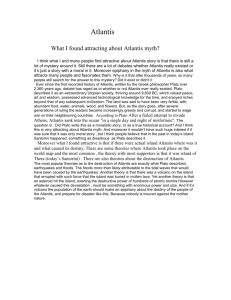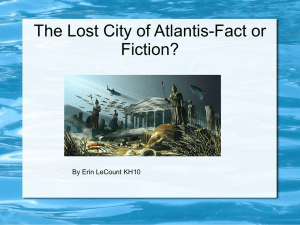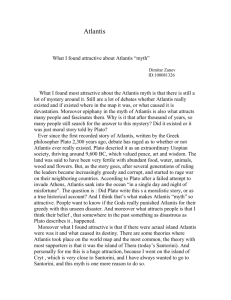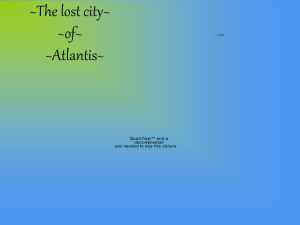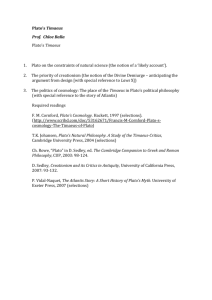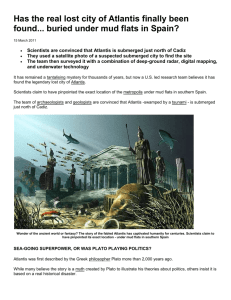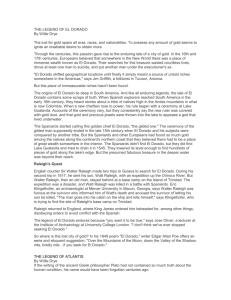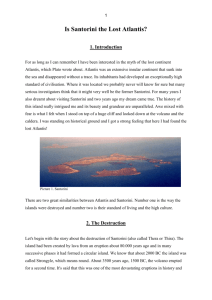aabiblio - Tufts University
advertisement
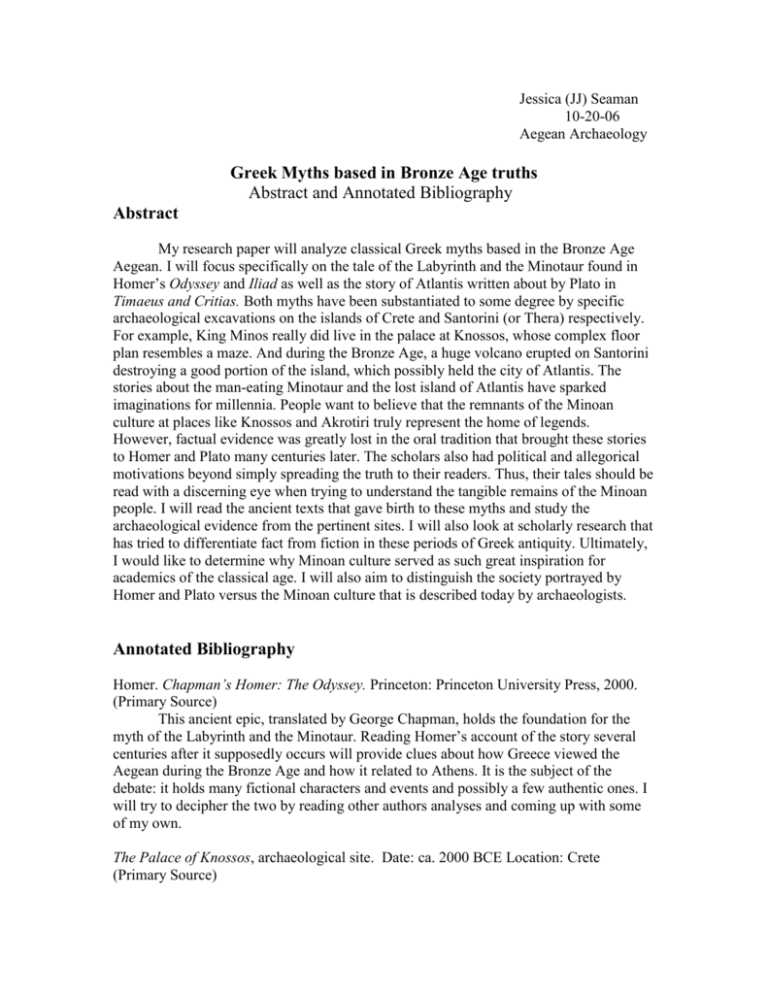
Jessica (JJ) Seaman 10-20-06 Aegean Archaeology Greek Myths based in Bronze Age truths Abstract and Annotated Bibliography Abstract My research paper will analyze classical Greek myths based in the Bronze Age Aegean. I will focus specifically on the tale of the Labyrinth and the Minotaur found in Homer’s Odyssey and Iliad as well as the story of Atlantis written about by Plato in Timaeus and Critias. Both myths have been substantiated to some degree by specific archaeological excavations on the islands of Crete and Santorini (or Thera) respectively. For example, King Minos really did live in the palace at Knossos, whose complex floor plan resembles a maze. And during the Bronze Age, a huge volcano erupted on Santorini destroying a good portion of the island, which possibly held the city of Atlantis. The stories about the man-eating Minotaur and the lost island of Atlantis have sparked imaginations for millennia. People want to believe that the remnants of the Minoan culture at places like Knossos and Akrotiri truly represent the home of legends. However, factual evidence was greatly lost in the oral tradition that brought these stories to Homer and Plato many centuries later. The scholars also had political and allegorical motivations beyond simply spreading the truth to their readers. Thus, their tales should be read with a discerning eye when trying to understand the tangible remains of the Minoan people. I will read the ancient texts that gave birth to these myths and study the archaeological evidence from the pertinent sites. I will also look at scholarly research that has tried to differentiate fact from fiction in these periods of Greek antiquity. Ultimately, I would like to determine why Minoan culture served as such great inspiration for academics of the classical age. I will also aim to distinguish the society portrayed by Homer and Plato versus the Minoan culture that is described today by archaeologists. Annotated Bibliography Homer. Chapman’s Homer: The Odyssey. Princeton: Princeton University Press, 2000. (Primary Source) This ancient epic, translated by George Chapman, holds the foundation for the myth of the Labyrinth and the Minotaur. Reading Homer’s account of the story several centuries after it supposedly occurs will provide clues about how Greece viewed the Aegean during the Bronze Age and how it related to Athens. It is the subject of the debate: it holds many fictional characters and events and possibly a few authentic ones. I will try to decipher the two by reading other authors analyses and coming up with some of my own. The Palace of Knossos, archaeological site. Date: ca. 2000 BCE Location: Crete (Primary Source) Knossos is a palace from the neo-palatial period, where King Minos once lived. It was discovered in the early 20th century by Sir Arthur Evans, and is still currently being excavated. According to Homer, it is where Theseus slayed the Minotaur and escaped the great Labyrinth, in order to win over King Minos’ daughter Ariadne. There are elements of it that resemble a labyrinth and the wall paintings found within it show that the Minoan people did have a significant relationship with bulls. However, there is a lot more to the palace than that described by Homer. Its lustral basins, throne room, and pillar crypts show that there were cult happenings whether or not they related to a labyrinth and a Minotaur. The palace will help me know what the real evidence is for the myth. Plato. Timaeus and Critias. (Primary Source) These dialogues between ancient scholars are the oldest known documents to describe the legend of Atlantis. In Timaeus, Plato mentions Atlantis only briefly, and spends the rest of his time discussing the creation of the world and natural phenomena. In Critias, he goes into a more detailed account of the lost island and the people that lived there. It is the literature that academics use to debate the location and existence of Atlantis. This will help determine whether the island of Santorini is a likely origin of the myth. Gill, Christopher. Plato: The Atlantis Story. Great Britain: Bristol Classical Press, 1980. (Secondary Source) Gill focuses on Plato as the originator of the myth, as he was the first one to make any mention of Atlantis. He includes an introduction that lays out contemporary theories about the island and looks at Plato’s possible motivations for writing it. He approaches the issue from different angles, encapsulating history, archaeology, and philosophy. Gill appears to support the idea that Plato’s story is a political allegory about the “ideal state and a suitable opponent.”(xxiii) Gill’s thorough comparison will help me interpret Plato and give me a better idea about the real inspiration for the mythical tale. Forsdyke, John. Greece Before Homer: Ancient Chronology and Mythology. New York: The Norton Library, 1964. The book examines the relationship between mythology and archaeology, and how in ancient Greece the former is often used to interpret the latter. Because there’s very little literature from the Bronze Age, we rely on Classical scholars like Homer to understand the past. However, the system is flawed. Archaeological sites are authentic remnants of history with no explanation, and writings like the Odyssey are explanations with little basis in reality. Thus, Forsdyke tries to organize more factual chronologies and genealogies of ancient Greece. This source correlates with my overall topic, which is the attempt to reconcile mythology and archaeology. Luce, J.V. Lost Atlantis: New Light on an Old Legend. New York: McGraw-Hill Book Company, 1969. (Secondary Source) Luce provides a comprehensive analysis of the story of Atlantis, with a particular emphasis on Crete. He breaks the book into four sections called Plato’s Account of Atlantis, Atlantis and Minoan Crete, Thera and its Volcano, and Excavations on Thera. Where some scholars doubt Atlantis’ connection to the Aegean, Luce clearly feels otherwise. He provides scientific and literary evidence. His knowledge of Bronze Age Crete and Thera will help me with my research. Nichols, Marianne. Man, Myth, and Monument. New York: William Morrow and Company, Inc., 1975. (Secondary Source) The book deals with a similar search of the others: it tries to piece together the 300 year gap in records during the Bronze Age, which she also calls the Dark Ages. She covers a range of Greek myths bringing together archaeology and classical literature. I will specifically be using her work on Theseus and Crete for my paper. MacGillivray, J. Alexander. Labyrinths and Bull-Leapers. Archaeology The author of the article questions the work and conclusions of Sir Arthur Evans, the discoverer of Knossos on the island of Crete. As a successful archaeologist in his own right, he declares that Evans made inaccurate assumptions about Minoan culture involving their supposed Goddess worship as well as other aspects. He also tried to interpret the structure and wall paintings to fit the myth, which MacGillivray feels was wrong. I think that it is helpful to have opposing views in research so one can more fairly form his or her own opinions. Websites: www.geology.sdsu.edu/how_volvanoes_work/satnorini.html http://www.decadevolcano.net/santorini/atlantis.htm#Luce_1969 summarizes debate about Atlantis and Santorini. Includes the most relevant excerpts from Plato’s Kritias and Timaeus. Cites legitimate sources. “It is also important to note, that the connection between gods, humans and nature is always present and naturally embedded in Plato's and the Ancient world.” His references: - Friedrich, W.L. (1994) Feuer im Meer. Spektrum Akademischer Verlag, Heidelberg, Berlin Oxford, 256 p. - Galanopoulos, A:G: and Bacon, E. (1969) "Atlantis. The Truth behind the Legend." Nelson, London - Luce, J.V. (1969) "The End of Atlantis - New Light on an Old Legend." Thames and Hudson, London, 224 p. Fire in the Sea: The Santorini Volcano, Natural History and the Legend of Atlantis. By Walter L. Friedrich. Translated by Alexander R. McBirney. (Cambridge: Cambridge University Press, 2000. Pp. xiv, 258. $34.95.) Friedrich organizes his synthesis into four parts. He first examines the geography and geology of Santorini, including a clear explanation of plate tectonics. they are well prepared for the next, which focuses on the Bronze Age eruption. Here one finds an excellent analysis of the phases of the eruption as well as an attempt to evaluate its impact on Crete, home of the influential Minoan civilization. In part three, Friedrich concentrates on Akrotiri, the "Bronze Age Pompeii" still under excavation. Given Friedrich's geological focus, it is not unexpected that this section proves disappointing. Anyone seeking an in-depth examination of the town, both architecturally and culturally, should turn elsewhere. What is good about this section is Friedrich's reconstruction of the pre-eruption topography of Santorini. Minotaur by MacGillivray-bio of Arthur Evans Labyrinths and bull-leapers. MacGillivray, J. Alexander. Archaeology. v. 53. no. 6. 2000-11-01. p. 53GN700 .A725 Location Tisch Bound Periodicals Holdings v.1:no.1 (Jan. 1948)- v.58:no.6 (Dec. 2005) Note Missing: v.48:no.4
